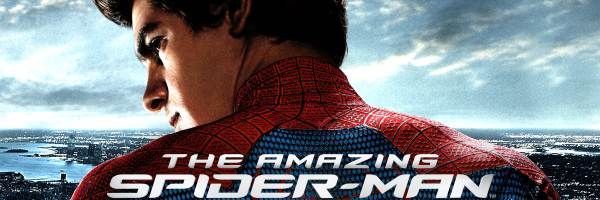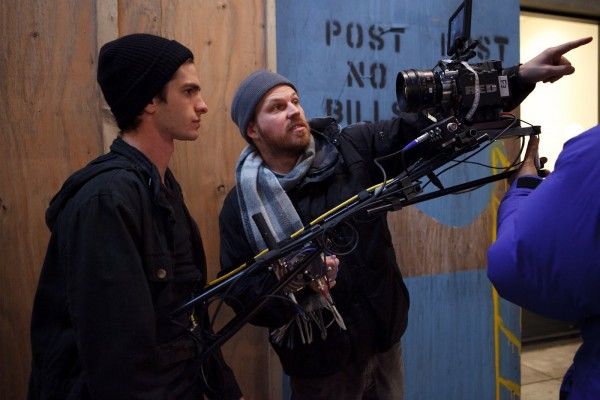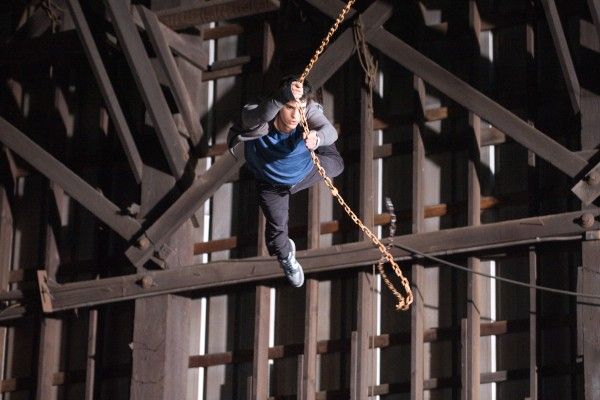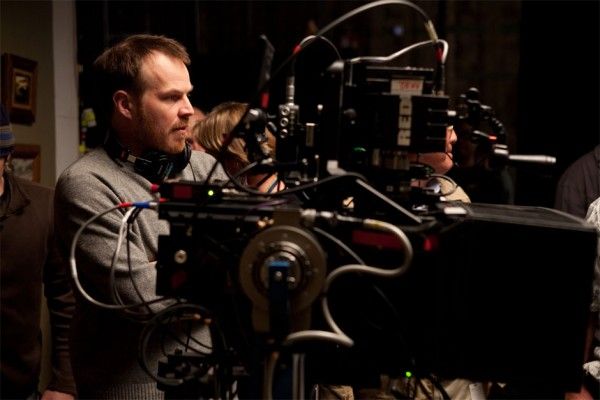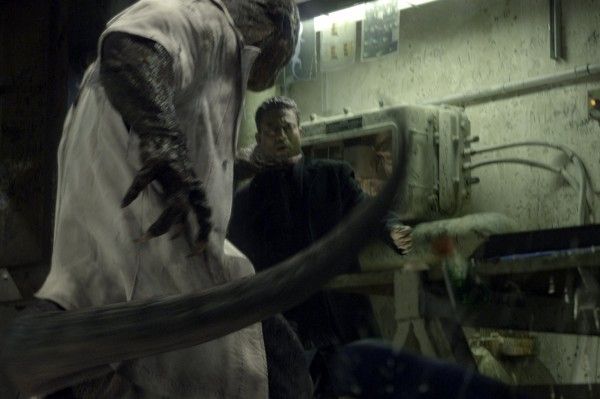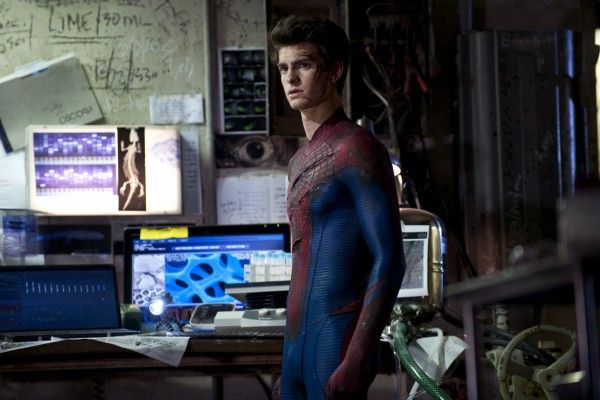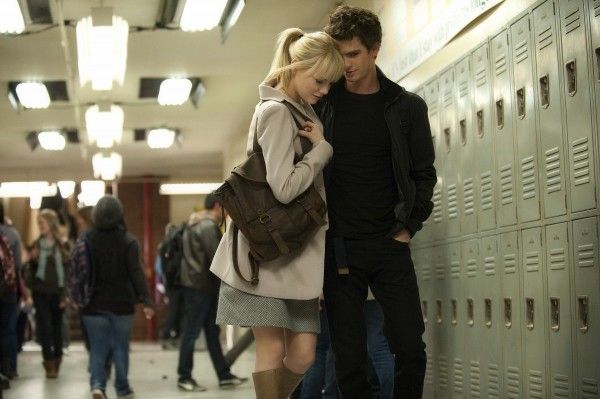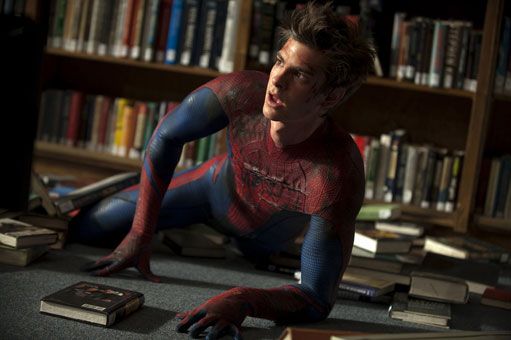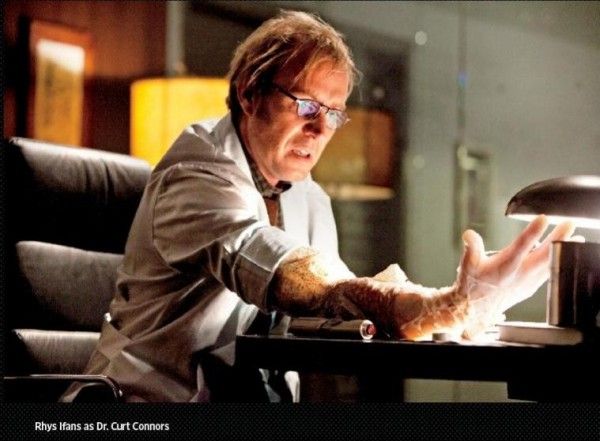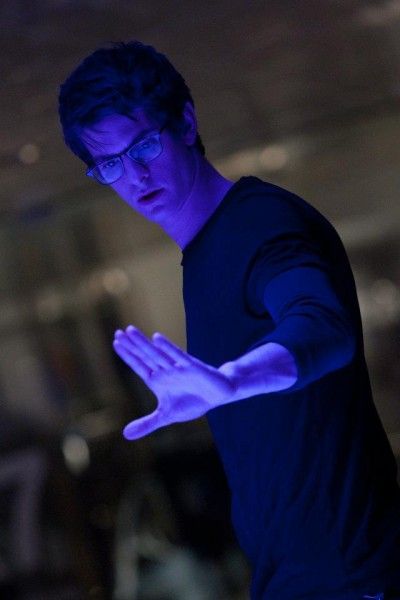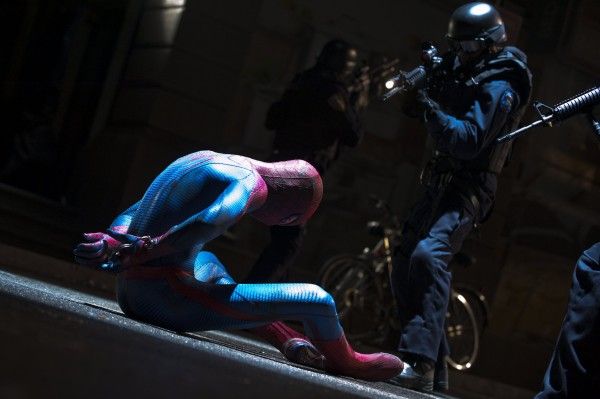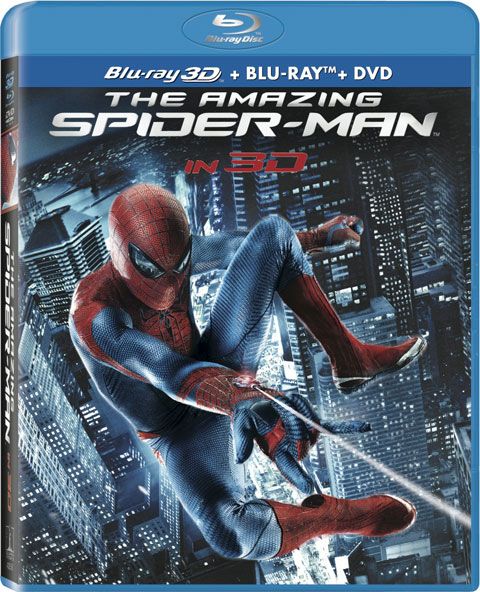The Amazing Spider-Man swings into the home entertainment market on Blu-ray/DVD today. At the behind-the- scenes press day, director Marc Webb, Sr. Visual Effects Supervisor Jerome Chen, Additional Animation Supervisor Dave Schaub, and 3D Visual FX Supervisor Rob Engle talked about the challenges of taking what 3D audiences enjoyed in theaters and putting that into an entertaining 3D Blu-ray. They discussed how their creative team worked together to create the amazing visual effects; why it’s important to know your script really well, commit to sequences and decisions early on, and look at everything in stereo as early as possible to avoid surprises later on; how using Real stereo cameras contributed to the sense of realism; who their favorite characters were; and why it’s important to think about how shots will play in depth and feel in 3D in order to strike a balance between creating an experience and telling a very human story.
Webb also revealed the three V’s of 3D -- vertigo, volume and velocity -- which made the experience more immersive, how the IMAX environment presented unique creative opportunities, how Jamie Foxx may play Electro in the next Spider-Man, and why his favorite bonus feature is the iPad Second Screen app which he thinks is really cool. Hit the jump for the Q&A, and click here to watch Steve's video interview with Webb about The Amazing Spider-Man 2.
Question: Marc, there’s a lot of emphasis these days on what’s going to go on the DVD and the Blu-ray. As the director, do those things enter your mind when you’re making the film?
Marc Webb: Not really. The making of the film is its own thing. You’re really focused on trying to make the script as good as it possibly can be. That said, there are certain moments where you’re like, you know what, I really like this sequence but it’s taking too long or it feels redundant. We’ll put it in the deleted scenes. There is a feeling that it’s not completely useless, that you’ve put all this work into a sequence and maybe we can [use it]. People will still see it, but not in the context of the film, so there’s some comfort there. But it is a secondary consideration when you conceiving the film. I grew up in the golden age of DVDs and I learned so much from commentaries and behind-the-scenes footage so I’ve really enjoyed that. In a very real way, a lot of the language that I learned in directing the film came from watching other directors or visual effects supervisors talk about it or seeing what pre-viz was or seeing how visual effects have worked and the history of that. That was a really informative, important part of learning about that. So there’s that, and then, there is an art form to the making of DVDs, and Charles de Lauzirika, who was really the author of the DVD, is one of the best guys around, and we spent a lot of time together perfecting and working on the DVD to make it as exciting, interesting and informative as possible.
I loved (500) Days of Summer and this is probably your first big blockbuster. How did your visual effects in Spider-Man work out?
Webb: (laughs) Compared to the visual effects in (500) Days of Summer? Actually, believe it or not, there were a lot of visual effects in (500) Days of Summer. There were a lot of split screens and there were animated sequences. But fortunately, these guys became my team, my go-to guys who could advise and help create the sequences in a way where we could exploit all the tools that were available to us. Jerome and I started working very early on together and it became a really fun, positive relationship.
Jerome Chen:Â Except when he hits me.Â
Webb: (joking) Well, he’s not supposed to make eye contact. That was the rule that we established very early on.Â
Chen: (joking) I can only sit on his left, and I can’t talk unless he looks at me and gives me permission to. But my job is just to take all the imagery that’s in his head, suck it out of it, and put it on the screen as long as it’s within budget.Â
Webb: We have a Planet of the Apes thing where he has to do this and it’s like…Â
Chen: We’re not supposed to talk about that. It’s a private thing.Â
Webb: There’s an incredible array of talent and Rob did the 3D part of it, which is an incredibly complex and nuanced task to create a stereo universe that felt authentic, legitimate, real, big and had a voice all its own. That’s a whole new kind of language, and Rob was a wonderful ally, and Dave who brought so much life and nuance into the movements of not only Lizard but Spider-Man itself. It’s a really involved process when you think about every little detail, every wrinkle on the suit, every head turn, every elbow crook, every piece of lighting, every reflection. All that has to be programmed, understood, manipulated and polished, and that’s what these guys are responsible for. It’s a massive Herculean task and we had a great group of people to do it.Â
Chen:Â It was fun.Â
Because of the way special effects are done, sometimes there are scenes that have to be worked on for the duration of the film. How tricky is it to know in advance that this scene is going to stay in the movie, work should be put toward this, and then have that locked when you’re trying to build the picture?
Webb: That’s a really good question. We started the point of view sequence very early on and our teaser was sort of a rough version of that, but the rendering of those sequences can take months.Â
Chen: Yeah, three days a frame. Something like that. Something ridiculous.Â
Webb: It’s trying to know your script as well as possible as early as possible and committing to sequences and decisions early on.Â
Chen: You don’t really know. I mean, you have to do what is best for the movie. Sometimes you may have an elaborate sequence and you cut the whole thing together and you find out you have to shorten this. It’s a really cool sequence by itself, but you watch it and you may have to cut it in half, even though you may have worked on it for some time and finished it to a certain degree. But, you always have to do what’s best for the entire picture. So, there are times where you have to cut something down. You don’t really know until you watch the whole thing together.Â
For Rob, what kind of challenges do you have taking the 3D that we saw in theaters and putting that in 3D Blu-ray? Is there any added work?
Rob Engle: Specifically, trying to transfer the film to work on the smaller screen versus the bigger screen, we certainly are thinking about that as we are filming the movie in the first place. One of the things that was great about this film and I think contributed to the sense of realism of the film was that we captured so much of the project using Real stereo cameras. And, as we were dialing the cameras, as we were setting things up, we knew that it was going to be seen on the small screen and we were certainly thinking about that at the time.Â
When you have a movie that’s so visual effects heavy, what are some of the things that you do as a director to make sure you strike a balance between creating an experience and also telling a very human story?
Webb: The first part is investing in the characters early in the film and there wasn’t a ton of action right off the bat. We tried to keep it as human as possible and make the drama king. And then, once you care and have invested in these characters, the action emerges and the 3D builds out. The scope of each sequence builds throughout the film so it’s really important to establish a foundation of character. That was of primary importance. And then, once you get into the action sequences, you know, there’s the kid on the bridge, and there’s the spectacle of it, certainly. But, there’s also an emotional, metaphorical scene going on and it’s Peter saving a kid. It’s a kid who was the same age he was when he was left behind. The intention was there was something moving within that action sequence where you cared. He’s handing off the child to his father, and his father is holding him like he was never going to be held again. The thing that he missed was right there in front of him. I think there’s something nice to have an emotional component to the action and sort of buttress or pin down all the big spectacle with moments of real human interaction.Â
Chen:Â That was beautiful.Â
Was there any thought of shooting at a higher frame rate?
Webb:Â Like at 48 frames?
Chen: 128 frames? (laughs)Â
Webb:Â Yes, exactly.Â
Chen:Â Nobody will be able to see it.Â
Webb: 256 frames. Well, I do 128. No. But I’m not poo-pooing it at all. I think it’s really exciting that people like James Cameron and Peter Jackson are experimenting. They’re pushing things forward. It’s awesome. We should encourage it.
For Dave, Jerome and Rob, how does your working relationship work when you’re working on a film that’s in 3D and how is it different building special FX that you know will eventually be converted into 3D, and at what point does Robb step in to help bring that to fruition?
Chen:Â We try to speak to Rob as little as possible.Â
Engle: That’s a good idea. That’s a good practice.Â
Chen: We try to look at the stuff in stereo as early as possible. What you’re implying is that we do the effect and then we convert it. We actually try to look at our dailies and everything in stereo right from the beginning if we can. So that means if it’s shot natively, that’s a little easier because your mask will move. You’ll be able to look at it natively. It it’s an all CG shot, we have the ability then to look at it in stereo as quickly as possible. There are certain cases where it will be converted, but the key I think is to look at everything with depth when we’re considering our creative decisions, which does mean that you do have to speak to Rob earlier than later so that when he animates, whatever spot he’s doing, going from near to far, you’re incorporating that creatively, and also so we can show Marc what is it really going to look like rather than having a surprise later on.Â
Engle: I would add too that I think one of the things even before the visual effects get started, it’s really important to think about how your shots are going to play in depth, how it’s going to feel in 3D, and I think some of the sequences in the film are really unique in that respect, that they really take advantage of depth. The scene where Spider-Man is working his way through the streets of Manhattan to OsCorp at the end of the film is a perfect example of one that is staged so well for depth. You’ve got this very long corridor of buildings you’re going down. The same is true of the high school battle. So, when it comes to the conceptualization of the film, thinking about it in 3D pays off dividends all the way down the road.Â
Dave Schaub: Once the layout is established for this world and we’ve kind of blocked in the shots, the work flow for the animators isn’t necessarily terribly different than what it usually is. We need to be aware of what’s going on in the scene. We need to make sure we’re not looking at it just through the primary camera, but we’re looking at it through what we call “witness cameras†from different angles, so that the character, for example, isn’t leaning toward the camera, which would actually show up in stereo. We’ve got to make sure we’re accounting for those kinds of things so that we don’t get any surprises when we actually look at it in stereo. But, as the animators are working, they’re working through one camera.Â
Webb: In terms of conceiving of sequences, when I was studying 3D early on, and I’ve said this before, to me there was always what I would call the three V’s of 3D: vertigo, volume and velocity -- and I was about to have a Rick Perry moment there. There was a laugh there. A few people got it. Vertigo is that sense where you look over the side of the building, that’s something that comes out in 3D in a very specific way. You can imitate it in 2D, but it’s a different feeling. And velocity, that feeling of moving really fast through an environment like that’s what that crane sequence is about. You get that in the very last shot of the movie where we’re swinging through the alleyway. That was designed specifically. We put walls near him so he’s going through a small space, or in the sewers, to feel that sense of dimension, that sense of space passing by. And then, volume, we added a lot of little dust elements and dust particles in the laboratory and around when the Ganali device goes off to create a sense of space and to accentuate that sense of space which helps the experience become more immersive.
When we first heard about the point of view sequence, it was a really interesting and intuitive way to use 3D and the special effects in this movie. Are you guys brainstorming other creative ways going forward?
Webb: Sure. You know what’s interesting is I had cut down the point of view shot. Originally, it was a longer sustained shot because I had only seen it in IMAX. I didn’t watch in IMAX until late in the game and I cut down that moment into maybe 12 seconds, or something like that, but originally it was maybe 40 seconds. I remember watching the abbreviated version of that point of view shot in IMAX when I went to test the IMAX version. I was like “Shit! I should have held on it!â€Â I should have held on it because it was up until the last minute when I cut it shorter. But there was a real feeling in the IMAX environment that was really great, and I learned a lesson then to be reverent of the IMAX experience and maybe we’ll do cuts that are specific for the IMAX in the future. I don’t know. But there was something about that environment that is unique and really exciting. It’s interesting. There are a lot of different formats through which people can view the movie, and whether it’s Blu-ray or conventional theater or IMAX theater, it’s something that’s on all of our minds.
There are directors like James Cameron whose point of view is that 3D should make it look like you’re actually there.  And then, there are other directors who prefer a more sensational approach. Do you have a preference for one or the other and does it change depending on what scene you’re shooting?
Webb: I tend to think more about depth than stuff coming out at you. Avi Arad, my partner and producer, is always like “Let it come out at you!â€Â So there are different philosophies even within our camp. But, for me, I don’t want people to be thinking about the 3D. I want it to enhance the sensation and the feeling. If it becomes too ‘in your face’ literally, it pulls you out of the story and it becomes a gimmick. Although, at the same time, in the very last scene, the very last shot of the movie, we pushed the depth. We pushed him out pretty significantly because we wanted to posture. We wanted to have one last fun moment of 3D where we’re little kids. I remember that feeling where you’re reaching out for that web and we wanted to create that sensation in the last minute of the movie, but we were very, very careful not to push it too far throughout the context of the film.
What’s your favorite bonus feature and the first thing you’d point people to watch in the film?
Webb: I think the iPad Second Screen app is really cool. That’s something that we’d worked on for a while. It’s just an interesting way to watch the movie. It’s like texting while driving but the safe version of it. We’re all addicted to having multiple devices on all at one time and it sort of satisfies your completely screwed up brain. I like that so that was fun. The behind the scenes stuff. To be honest with you, it’s a little sad to watch because two of our really wonderful people who we worked very closely with during the film, Laura Ziskin, our producer, and Michael Riva, our production designer, passed away. I was just looking at the DVDs over here and looking at some of the other features and it’s sort of heartbreaking, but it’s a great way to remember them to see their spirit in there. So every time I see them, those features, I get a little emotional. It’s really nice to see that. It’s sad but it’s nice.
After all the research you’ve done in the Spider-Man universe, which characters – villains or good guys -- do you guys like the most?
Webb: I like Electro. I’m fascinated by Norman Osborn and the different inflections of him in Harry. I think Mary Jane and Gwen have always been interesting to me.Â
Chen: The Lizard. The Lizard was cool.Â
Engle: We spent a year and a half with The Lizard, I think. I like The Lizard.Â
In the comics, with Curt Connors, they have a long relationship and a mentorship. Did you guys ever have questions in your mind like maybe we should hold them off for the next movie because it’s such an interesting relationship? Did you ever doubt any decisions about the villain?
Webb: Never. Never doubted.Â
Chen:Â None.Â
Webb: I have no self-doubt. (joking) Creative people don’t feel self-doubt at all. We have utter conviction and know. There’s your false answer.
The Lizard was a very CGI-heavy character.
Chen: We couldn’t find an actor that looked like him.Â
Webb: Yeah. God knows you tried.
Going forward, and you touched on Electro, are you going to try and have the next villain be as CGI heavy or are you going to focus maybe on a human?
Webb: It’s not really a part of the question. What makes villains interesting for me is what they bring out in Peter and what challenges they provide for him. What’s great about Marvel and other comics is that often there is a preexisting relationship, not all the time, but you have to define not only the physical obstacles that it provides the protagonist, but the emotional ones as well. That’s the fun thing to play with the villain.
One of the cool things about this as it was coming out was it had a very immersive viral campaign. Were you guys involved in that when it happened or did it just coincide?
Webb: It was something we talked about. That was a very new part of the process to me. We didn’t have a viral campaign for (500) Days of Summer.Â
You should have.
Webb: I should have? We had six dollars for the movie and they only used $5.60 of it, which was weird because I could use some Reese’s Pieces or something. But they were like “No, we can’t afford it.â€Â That’s something I thought was fun. It’s really for the hard core fans which are such a really important part of the nature of these films, of Spider-Man or any of the larger comic films. There’s this huge fan base and you want to honor that commitment and that enthusiasm and anything to do that is fun. We worked with a company, and I know there’ll be more of that, and I hope that we can get deeper into that universe. It’s also an interesting way to plant ideas about the movie so people can understand and to expand the universe, if you will. You know what I mean? Lost had all those great little websites and stuff and it just allows you to dig in deep. It’s like reading Lord of the Rings. There are so many details. We spent a lot of time talking about those details and whether or not they turn up on screen. They don’t always turn up on screen, but there’s a backstory there and it’s fun to exploit that and explore that.
Is it true that Jamie Foxx might be in the next one?
Webb: We’ll see. I think Jamie Foxx is electrifying. Ohhhh, I didn’t actually say that! I think Jamie Foxx is one of the most brilliant actors that we have around today. He’s such a great character actor. He’s a really brilliant guy and I would love to work with him so… Â
Chen: We’ll see.Â
Webb: You’ll be hearing more on that shortly, I’m sure.
How are you going to push yourselves to another level that’s greater than what you’ve already done?
Webb: Steroids. Steroids and drug abuse. No. Please strike that. I really don’t want kids reading that.Â
Chen: Good thing there’s no press here. That’ll never get out.Â
Webb: Exactly. Sarcasm doesn’t always translate in print. This is one of the first lessons you learn.Â
Chen: Yes. You’ve learned that?Â
Webb: Clearly not. Listen, there was a time, after we finished the first movie, I was like “I need some time off†and then I went away for three days and I’m like “I’m bored.â€Â I started talking to …Â
Chen: I said to Marc, “Stop calling me. We don’t need to work right now.â€Â
Webb: It’s just so exhilarating to be part of that universe. It’s just its own fuel. Even before the first movie, we’d spent a lot of time building a larger universe. And so, to let that go, it’s hard to step away from it because your brain is primed. It’s exciting to play around in that sand box. So I don’t know. It’s an addiction. It really is.Â
Chen: There you go again. It’s not an addiction. They’re going to skip everything else and say there’s steroids, addiction and drug addicts.Â
Webb:Â Those are the big words.Â
The Blu-Ray/DVD Combo Pack is loaded with hours of bonus features, 90 minutes of behind-the-scenes documentaries, deleted scenes, and audio commentary. The Blu-ray Exclusive “Amazing Spider-Man Second Screen App†features a full movie sync option with director’s notebook including additional interviews, pre-visualization sequences, and production timeline. The Blu-ray 3D Disc exclusive bonus content includes Interactive 3D 101 with Marc Webb and 3D Scene Progression Reel.

